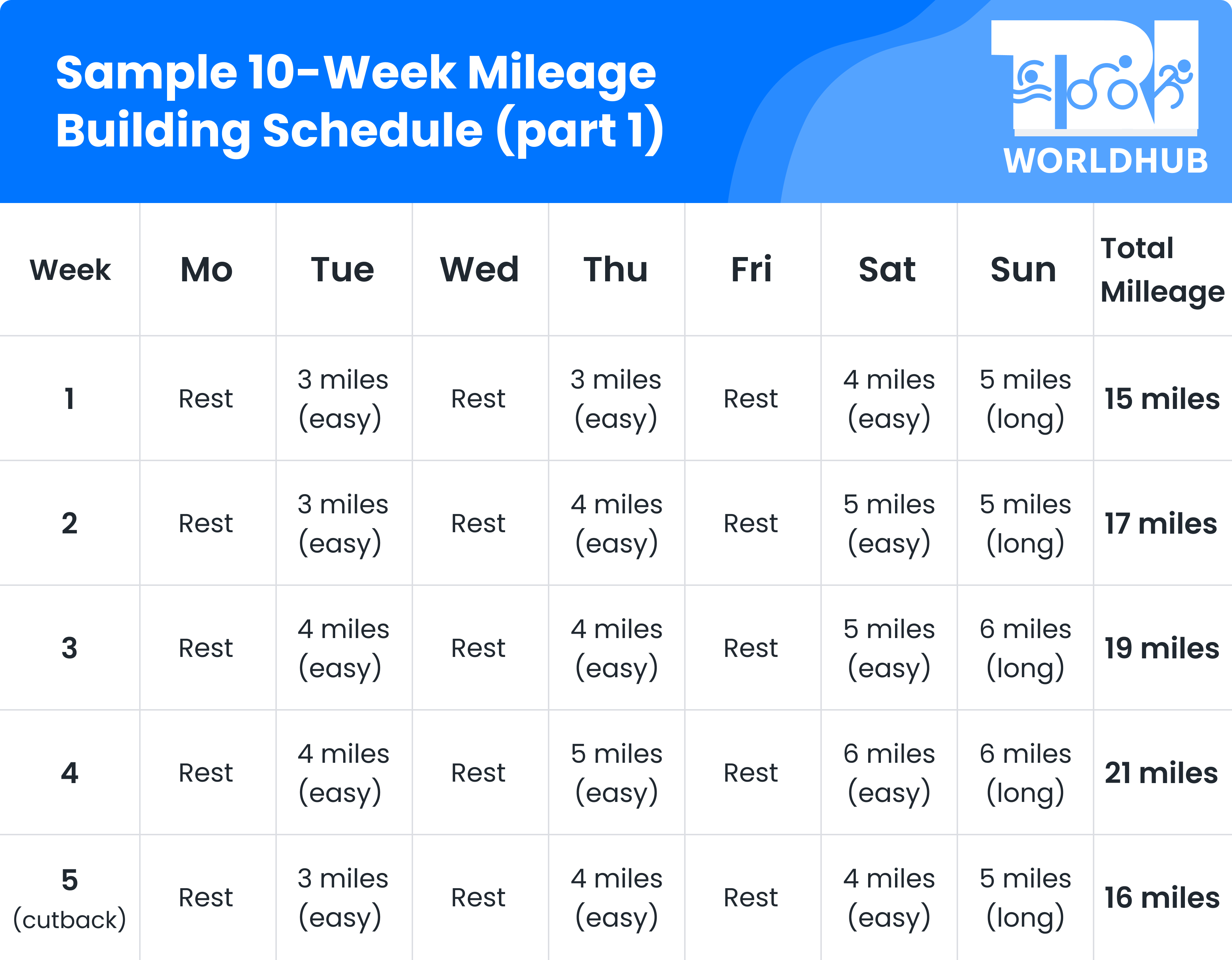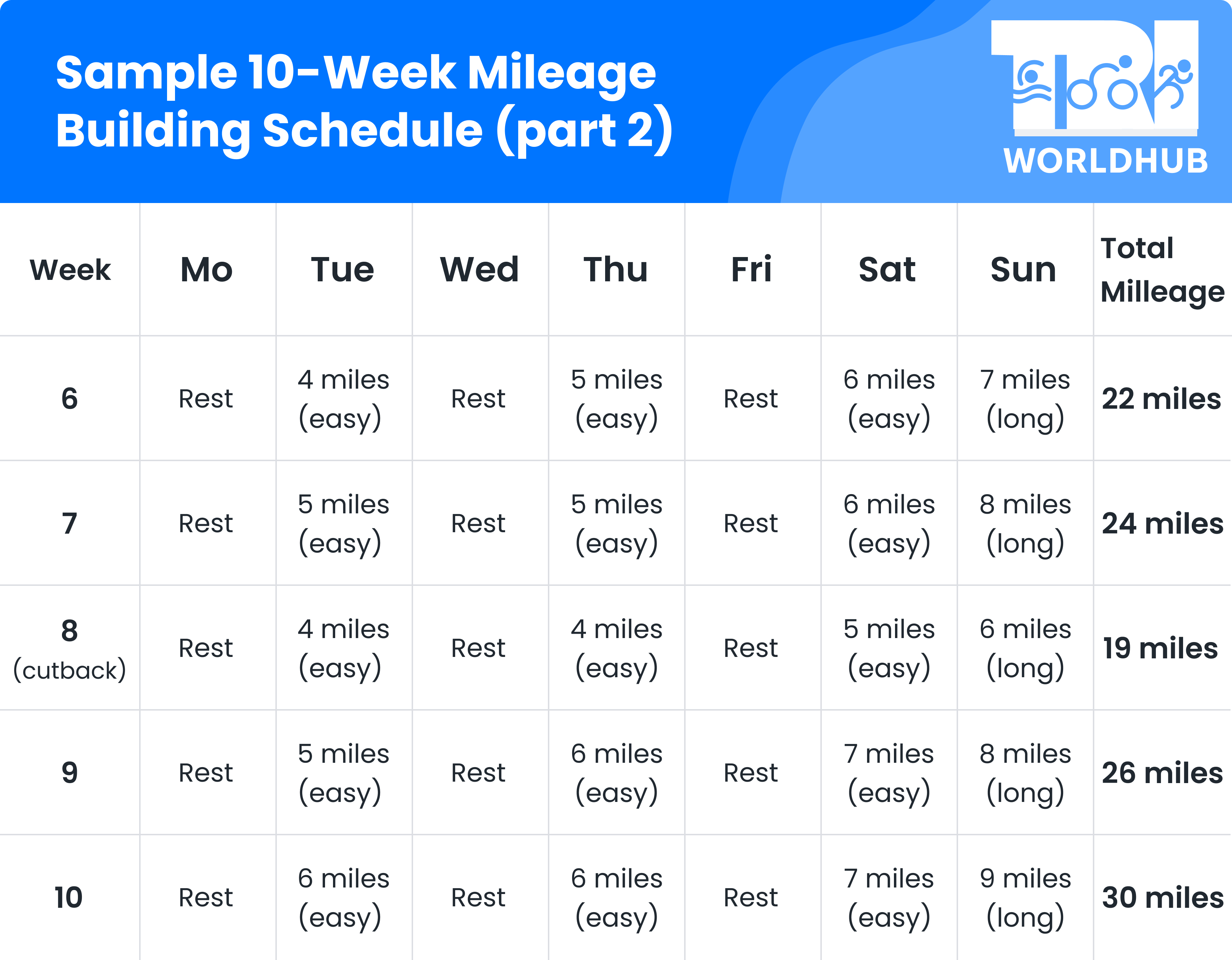Are you in the middle of your marathon training? Or just want to improve your running performance?
Then, increasing mileage is the best thing you can do to become a better runner.
More mileage can indeed improve your endurance and, indirectly, your speed.
However, there’s a fine line — doing too much too soon without focusing on recovery is a common recipe for injury or burnout.
To safely reap the benefits of higher mileage, you need to be patient, strategic, and mindful of how your body responds to the increased load.
Even though we all know someone who can run as much as they want whenever they want without becoming injured, the risk of running injuries increases substantially once we enter the higher mileage & frequency end of the spectrum.
Studies on running-related injuries show that increasing running mileage too fast is a key factor in injuries (60-70%).
So, how do you increase your run mileage safely?
Let’s find this out.
This article will be a useful read for both low mileage runners and higher mileage runners as preventing injuries is the best thing you can do to improve your performance.
Understanding the Importance of Running Mileage
Increasing weekly running mileage is crucial for improving running speed, endurance, and strength.
When you slowly increase your weekly mileage, your heart and lungs get stronger.
That means they can deliver oxygen to your muscles more efficiently, so you can keep up a good pace for longer.
Plus, those extra miles help toughen up your muscles, tendons, and bones, making them more resilient to the constant pounding of running.
But here’s the catch.
If you increase your mileage too quickly, it can lead to injuries like shin splints or stress fractures, which no runner wants.
Especially before the big race.
The real benefit of steady mileage I want to highlight is that it also helps with mental endurance.
You train yourself to stay focused and push through longer races.
Of course, reaching your peak mileage is not the only way to get better, but a solid mileage foundation can make speed work and race prep much more effective.
For me, just like for many runners out there, the goal is to find that sweet spot where mileage brings steady progress without burnout or injury.
So, how do you increase your running mileage safely?
Here are a few things to keep in mind:
1. Keep Track of Your Load
A few things to keep an eye on are:
- How much you’re running: Are you adding miles slowly, or did you jump up too fast?
- How hard you’re pushing: It’s great to challenge yourself with intervals or hills, but balance that with easier runs.
- Rest and recovery: Getting enough rest, stretching, and downtime are just as important as your run days.
2. Listen to Your Body
It’s all about building up gradually.
When your body feels too tired, it’s okay to dial it back.
Give yourself a break so you can keep running strong, without having to take a forced break because of an injury.
Passion gets you out the door, but balance is what’ll keep you running for years.
3. Monitor Load and Stress
It’s vital to monitor your weekly running load, which includes:
- Mileage: How much you’re running each week.
- Intensity: How hard those miles feel, including any intervals, sprints, or hill workouts.
- Recovery: The time you give your body to rest and recharge. This includes quality sleep, stretching, and even relaxation to avoid mental burnout and post-workout insomnia.

How to Build a Foundation for Increased Mileage?
Build a solid mileage base before increasing mileage.
When you’re training to hit a big weekly mileage goal — like 60 miles — you don’t want to jump in all at once.
Start with runs of 40 miles, then 46 miles, and finally 52 miles over the course of a few weeks.
After that, it’s smart to dial it back a bit to around 46 miles.
This little break gives your legs time to catch up and really soak in all the work you’ve done.
Let your muscles and joints recover so they’re ready to take on more miles without breaking down.
Consistency in your running is super important.
Anytime you change your routine — especially when it comes to upping your running mileage — your body feels the stress.
This is why injuries often pop up during these buildup phases.
Once your body gets used to a certain mileage, it becomes much easier to keep hitting those numbers week after week without feeling overwhelmed.
Also, you want to incorporate strength and conditioning training to support running and reduce injury risk.
Let’s explore the best strategies to increase your total weekly mileage.
3 Safe and Effective Strategies for Increasing Mileage
In the runner’s world, there are many ways how to run faster, further, and better.
Here are a few strategies that can help you improve your running mileage without training stress.
The 10% Rule
As the name implies, the 10% rule means you increase your mileage by 10% each week.
First, you need to calculate what 10% of your weekly mileage is, then increase your mileage each week by no more than that amount.
Let’s say, you usually run 10 miles per week.
Then, you need to increase by no more than 1 to 1.5 miles the following week.
While it may feel slow, especially when you’re eager to progress, it’s a reliable way to reduce injury risk.
It’s also adaptable — on weeks where you feel particularly strong and injury-free, you could add slightly more.
On tougher weeks, you might increase less or even maintain your current mileage.
This slight increase will help you better adapt to longer distances and avoid injuries.
In fact, the research from the British Journal of Sports Medicine highlights that athletes who increase mileage too fast have a higher risk of injury compared to those who do so gradually.
Cut-Back Weeks
Every three to four weeks, add a “cut-back week” where you reduce your mileage by about 20–30%.
So if you’re running 40 miles a week, drop down to around 30–32 miles for a week.
These reduced-mileage weeks give your body a chance to recover, which is essential for muscle and tendon repair and overall adaptation.
You’ll feel fresher afterward and less likely to experience overuse injuries.
These mini “rest periods” also help keep you mentally motivated by breaking up the intensity of constant mileage increases.
Focus on Easy Pace
As you increase mileage, you want to keep most of your runs at an easy, conversational pace.
This is also often called “zone 2” in heart rate training.
Running at this pace allows your body to accumulate more miles without the added strain of high-intensity workouts, which is crucial as your body adjusts to the new mileage.
This easy pace not only reduces injury risk but also builds aerobic endurance, the foundation for faster running down the line.
As you adapt to the higher mileage, you can gradually incorporate tempo runs or speed work into your training, but keeping the majority at an easy pace helps prevent burnout.

Managing Injury Risk and Recovery
Here are a few tips from professional running coaches for better recovery and reducing the chances of injuries.
Recover and Fuel Properly
Recovery days and balanced meals aren’t just “nice-to-haves” – they’re essential for getting stronger.
Give yourself rest days and lighter workout days to allow your muscles to repair.
You also want to take care of your nutrition.
Fuel your body with a mix of carbs, proteins, and healthy fats to replenish energy and aid muscle recovery.
And don’t forget to stay hydrated. Water helps your muscles work smoothly, reducing the chances of cramps and tightness.
Check out our article on how to prevent cramps while running for more insights on this topic.
Incorporate Cross-Training to Give Your Legs a Break
Cross-training, like swimming, or cycling is a great way to build endurance without the constant pounding of running.
It helps keep your fitness up while giving your joints and muscles a breather, which is especially useful during high-mileage weeks.
Plus, a bit of variety in your routine can keep things interesting and prevent burnout.
Add Strength Training
Strength training makes a big difference in injury prevention.
You want to focus on exercises that strengthen your core, as well as your abductor and adductor muscle groups (learn more in our blog Abductor vs Adductor Muscle: What is the Difference?).
Incorporate strength workouts two to three times a week.
Stronger muscles help your body handle the impact of each step, which reduces stress on your joints and can prevent common injuries like runner’s knee pain or Achilles issues.
Here, we share top stretches for runner’s knee.
Sample Schedule for Building Mileage
Here’s an example of a training plan that will help you improve your mileage safely.
However, I do recommend you reach out for a professional coaching service.
A specialist can help you create a training program that is focused on your goals and incorporates your current running form.


Each week includes an increase of about 1-3 miles. This slow increase gives your body time to adapt without overloading it.
Cut-back weeks allow your body to rest and recover, reducing the risk of overuse injuries.
This is just an example of how your running week can look.
Regardless of your mileage, your week should include long runs. These runs are progressively longer but are balanced with cutback weeks.
All mid-week runs are “easy” pace runs. You should be able to run at a conversational pace without overexerting yourself.
Rest days are essential for recovery.
Feel free to add cross-training, like cycling or swimming, on one of the rest days if desired, but avoid high-intensity activities that might interfere with recovery.
How Much Mileage Increase is Too Much?
The precise answer will depend on numerous factors, including your goal, pace, physique, etc.
However, there is one study I think might help you get the idea of how much is too much when it comes to mileage increase.
The study published in the Journal of Orthopaedic and Sports Physical Therapy looked at 874 runners who had just started running on their own, each using a GPS watch to track their distance after every run.
The runners were divided into three groups based on how much they increased their mileage each week:
- Those who increased by less than 10% each week
- Those who increased by 10% to 30%
- Those who increased by more than 30%
The main goal was to see if these different rates of mileage increase affected their chances of getting injured.
Out of all the runners, 202 ended up with some kind of running-related injury.
Overall, there wasn’t a big difference in injury rates across the three groups.
However, the group that increased their mileage by more than 30% had a slightly higher chance of developing specific injuries, like knee pain and iliotibial band issues, compared to those in the lowest increase group (less than 10%).
That said, this difference wasn’t strong enough statistically to be fully conclusive.
So, even though increasing your mileage by over 30% might not be as dangerous as many may think, it is still a good idea for new runners to keep their mileage increases below 30% to play it safe.
Conclusion
Increasing your running mileage is a complex process.
It requires patience, consistency, and a well-structured training plan.
Beginning runners tend to rush the process since they want their results here and now.
Especially when training for their first marathon.
But they may end up having injuries, burnout, or even decrease in motivation (here, we talk about athlete motivation strategies in more detail).
To avoid injuries that will only postpone your progress, make sure you prioritize recovery and gradually increase the mileage.
As with almost everything in life, progress takes time.
So, stay patient, increase mileage safely, and enjoy the process!
And feel free to check out this base running training plan to level up your endurance and performance.





